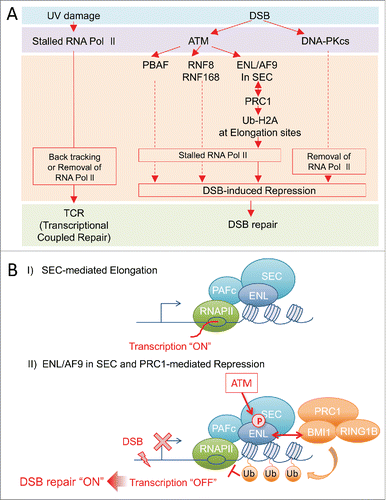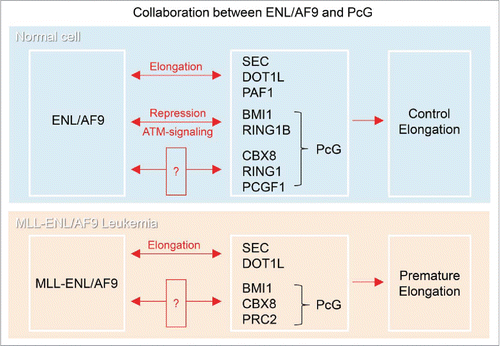Figures & data
Figure 1. (A) Link between DNA damage and transcription, and pathway of DSB-induced transcriptional repression. (Left) UV damage-stalled RNA Polymerase II recruits NER proteins and induces transcription coupled repair (TCR). (Right) DSBs activate ATM and/or DNA-PKcs and promote DSB-induced transcriptional repression and DSB repair. Under the ATM-signaling, PBAF, RNF8/RNF168 and ENL/PRC1 were reportedly involved in DSB-induced transcriptional repression. (B) Models of collaboration between ENL/AF9 and PRC1 in DSB-induced transcriptional repression. I) During transcriptional activation, ENL/AF9 in SEC promotes transcriptional elongation. II) When DSB(s) is introduced near transcriptional sites, ATM phosphorylates ENL/AF9 at evolutionarily well-conserved SQ-sites. This phosphorylation of ENL/AF9 recruits PRC1 at transcription-sites through BMI1 to promote ubiquitination of H2A and transcriptional repression. Thus, ENL/AF9 in SEC would be key factors for the switch of transcriptional elongation to rapid repression, in response to cellular signaling. Dot-line indicates that it is not clear how these factors repress transcription.

Figure 2. (Top) Collaboration between ENL/AF9 and PcG. ENL/AF9 was reported to interact directly with SEC, DOT1L and PAFc and promote transcriptional elongation. ENL also interacts with PcG proteins, CBX8, RING1 and PCGF1, but the cellular function of the interaction remains unknown. We found that ENL interacts with the E3-ubiquitin ligase complex in Polycomb Repressive Complex 1 (PRC1), BMI1 and RING1B, and these work together to repress transcription under ATM-signaling. Therefore, ENL functions in both transcriptional elongation and repression depending on the circumstances. (Bottom) Collaboration of MLL-ENL/AF9 with PcG in Leukemia. PcG is involved in the tumorigenesis in MLL-ENL/AF9 rearranged Leukemia. “?” show the interaction, of which meaning is not clear or controversial.

